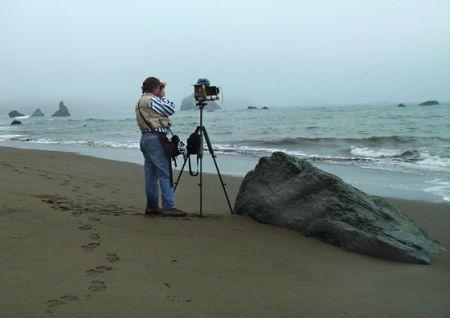Artis
The specific brands of equipment and film I use have no more impact on my final images than a particular word processing program has on the work of a novelist. Quality equipment is important, but only to the extent that the tool is usable for its purpose. General categories and specific techniques, however, do make a difference. I have chosen my specific photographic medium and methods, my instrument and technique so to speak, to suit my artistic vision, preferences and personality.
My photographs in the field are made with a 4x5-inch wooden folding field camera, still-lifes and some city work with a 4x5-inch monorail camera. I prefer large camera and film not only for the inherent advantages regarding grain and enlargement, but also because the view camera provides movements for controlling perspective and plane of focus, allowing me to make photographs that would be impossible without them. For me, the 4x5-inch size is the perfect compromise between capability and portability.
I normally find it advantageous to locate the desired camera position and compose the image before setting up the camera. I often use a viewing frame to assist in this, which also helps in lens selection. At this point the camera is set up, the desired lens mounted and the subject positioned on the ground glass. The camera is then adjusted, the image carefully focused, filters chosen and exposure calculated. The inverted and reversed image is many times helpful in refining organization and final positioning by somewhat abstracting the formal elements of the scene.
For exposure and development, I use my own version of the Zone System developed by Ansel Adams. Several subject luminescences are metered using a one-degree spot meter and one of several development schemes chosen depending on subject contrast and visualization. The exposure is then made. I develop my negatives singly or in small batches by hand in trays. I use high-acutance and pyro staining developers with long developing times for their superior sharpness, and compensating and edge effects. The pyro developer, due to its staining characteristics, has the added advantage of masking the grain a bit and holding highlight detail and is now my developer of choice for most situations despite the precautions needed because of its toxicity. I many times further control the contrast range and proportion of tonalities on the negative by using Selective Latent Image Manipulation Techniques (SLIMTs). In this procedure, negative contrast is reduced in proportion to exposure by treating the negative in an extremely diluted bleaching agent before developing. This allows me even more contrast control while retaining critical shadow detail that usually is lost when reducing negative contrast.
I print solely on premium-quality fiber-base glossy paper. I find the air-dried glossy finish to display the fullest range from black to white and to be the most aesthetically pleasing. Furthermore, fiber-based papers are generally considered to be more permanent than resin-coated papers. I prefer neutral black, or “cold tone†papers on a bright white base to warmer-tone papers. These, however, I normally tone to warm the green-black or blue-black image tone somewhat.
I use no multiple-printing techniques or digital manipulations or “enhancements†in my printing. It is not that I feel that such manipulations are artistically invalid, it is simply that my vision precludes such practices. I do, however, use a variety of traditional printing manipulations including dodging and burning, flashing, masking, split-contrast printing, selective developing, bleaching and toning.
Special attention is taken to process the prints for optimum permanence. A two-bath fixing procedure is used, with care to insure that capacities are never exceeded. Thorough washing insures complete removal of residual chemicals, and toning in selenium protects the prints from environmental pollutants. All prints are mounted using a buffered reversible dry mounting tissue to 100% cotton rag buffered museum board and framed using chemically inert materials.

